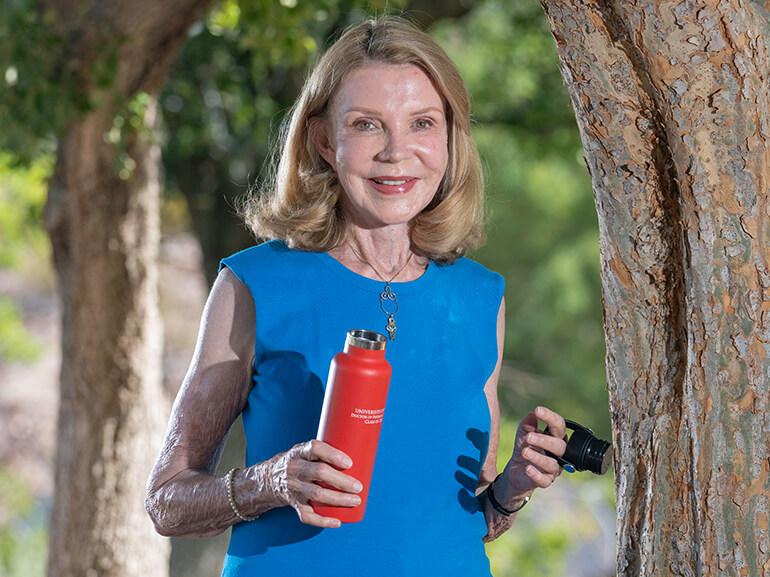Carol's Story

Carol Campbell spent her career as a defense electronics engineer before retiring in Nevada where she keeps herself busy golfing and working out seven days a week. One day, after returning home from the gym, Carol slipped while getting out of the shower. She was taken to the local hospital where they performed an X-ray and determined Carol fractured the top of her femur, requiring a partial hip replacement.
A few days after surgery, Carol was ready to get up and moving again. She initially wanted to go home, but her doctor recommended that she go to a rehabilitation hospital for additional recovery time. She chose Dignity Health Rehabilitation Hospital. Carol is glad she listened, saying, “Had I come home without going to the rehabilitation hospital, my risk of re-injury would have been much higher.”
Carol lives alone, and with her children, grandchildren and brother all living in California, her ultimate goal was to return home with full independence. “I told the therapy team I wanted to walk out of the hospital unassisted,” said Carol. She thought it was a long shot, but wanted to aim high.
In physical therapy, Carol focused on getting up and walking. She said her biggest challenge was fear, sharing “The physical therapy is as much mental as it is physical because you have to learn a new way to do things.”
About one week into her stay, she recalls a particular therapy session where her therapist wanted her to leave the walker behind and take a few steps on her own. Sensing Carol’s hesitancy, the therapist directed her to throw a small ball from one hand to the other – a distraction technique. Before Carol even realized what was happening, she was walking on her own and amazed at her progress. “I stopped in my tracks and said ‘you tricked me’ and he smiled. I had just gotten used to being on my feet and couldn’t believe I was walking on my own.” This was Carol’s first “a-ha” moment because she realized she was going to reach her goal.
In order to prevent another injury, Carol had several physical restrictions. She was instructed not to cross her right leg over the center of her body or bend her right hip joint more than 90 degrees and was to sit in a reclined position until everything healed. This led to Carol needing to learn how to do everyday tasks in different ways, such as using a device to lift her leg while getting into bed. To help with balance, therapists had Carol practice stepping sideways as well as catching and throwing a ball while standing. Stairs were a big challenge for Carol, so her therapists had her start with small steps just a few inches from the ground, and once she got comfortable with that range, she progressed to a regular staircase. Carol considered that as a huge milestone in her rehabilitation journey. Carol felt occupational therapy was “absolutely crucial” to regaining her independence. “If I went home without having occupational therapy, I wouldn’t have progressed.” She credits her team with teaching her new ways to do everything she would need to do once back home. They taught her to safely get into and out of a car, load a dishwasher, use the washing machine, get dishes out of lower cabinets and go grocery shopping. She was also shown how to safely get in and out of the shower and introduced to certain tools to help make her bathroom safer at home such as a shower seat, non-skid mats and where to hang her towel so it was easily within reach. They even covered how to put trash out using a rolling walker. Carol and her therapy team practiced it repeatedly in the hospital setting so there were no hurdles or surprises when she returned home. “I didn’t have anyone living with me, so if I couldn’t do it myself, it wouldn’t get done,” said Carol.
After 12 days, Carol was discharged fully independent in all daily tasks and walking without any assistive devices. “I wasn’t using a walker, a cane or anything. I walked right out and got in my brother’s car.”
Prior to the accident, Carol was in great shape, which she feels helped her meet her goals. While she looked forward to returning home, Carol admitted she was scared. “I learned what I needed at the hospital, but to go home and do it was another story.” However, the fear diminished once she started to get into a routine, doing everything she learned from her care team.
Although Carol’s family wasn’t able to visit her in the hospital due to living so far away, they were there to help when she returned home. Her brother stayed for several days after discharge to help Carol get settled in. He helped put things where she could easily reach them and installed a grab bar in the bathroom. They also had to move furniture so there were no trip hazards. Her son and daughter came a few weeks later to help out, and Carol hired a driver to run errands and take her to outpatient therapy, which she did for 13 weeks at Dignity Physical Therapy.
“My experience was wonderful,” said Carol. “I learned the value of therapy. You don’t realize how essential it is until you do it. I learned to trust my team, and it worked.”